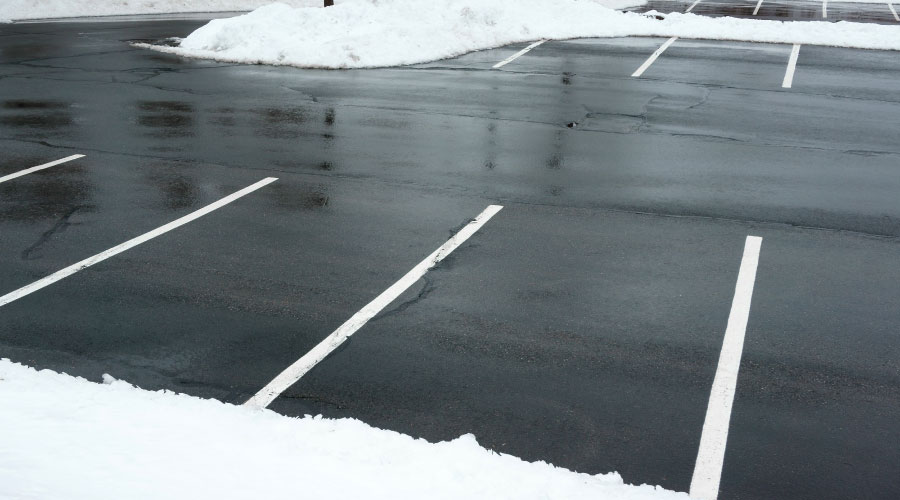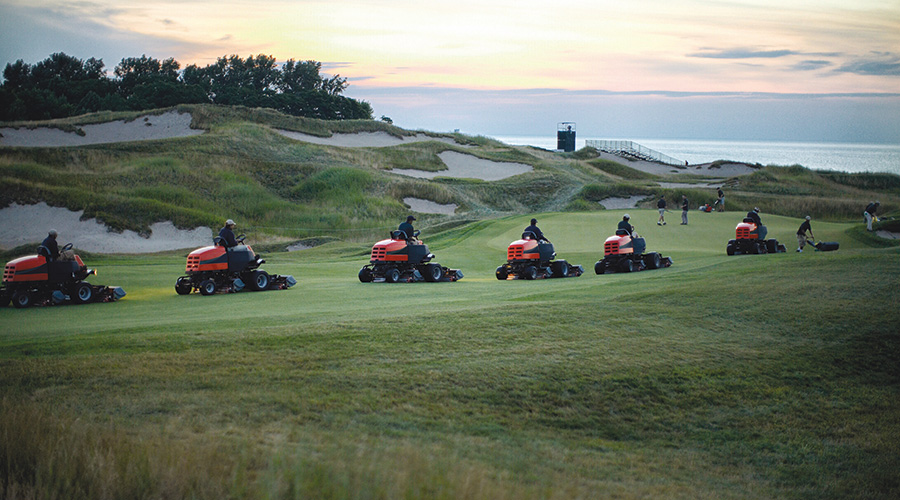Winter-Preparation Equipment Strategies
Grounds care workers depend on a range of equipment to take proper care of the lawns and landscapes they maintain, and taking proper care of the equipment can help managers ensure efficient and cost-effective operations.
Fall is an ideal time for equipment operators and mechanics to begin preparing mowers, tractors, utility vehicles, and hand-held equipment for the tough jobs and tougher conditions that winter is certain to bring.
Extending Use
In the fall, grounds crews traditionally are busy mowing, and many are following strict schedules related to equipment preparation.
“This week, we are putting cabs on the utility vehicles,” says Walter Bonvell, grounds superintendent with Xavier University in Cincinnati. “They are not heated, so we take extra time to make sure the rubber seals are tight. We do everything we can to stay comfortable in the cold weather.” Crews use the vehicles for transportation throughout year.
“We transport people, mostly, but also snow shovels and bags of ice melter when needed,” he says. During September and October, Bonvell’s workers begin preparing snow-removal equipment ready for winter use.
“Each piece is pulled from storage and inspected to be sure it is ready to go when the first snow or ice storm arrives,” he says. “If any piece needs work, we can get it done now before we need it.” Crews use most of the equipment in both summer and winter.
“Our large commercial mower gets fitted with a V plow and is used for removing deep snow on the major walkways,” he says. “We have two smaller riding mowers that accommodate snow brooms or snow blowers and are used on regular-size walks. These mowers also have cabs for extra operator protection and chains put on the tires for extra traction in snow and ice.”
Operators also converts a large commercial tiller into snow broom or blower, and they attach a broom to a skid loader for use on brick paver walks that are prone to scratching with a regular plow blade.
Fuel Considerations
Managers want to consider having mechanics add a fuel stabilizer to the gas tanks of mowing equipment and tools with small engines, including line trimmers, hedge trimmers, and leaf blowers, says Steve Meyer, co-owner of Midwest Equipment in Normal, Ill.
“Especially in the smaller-capacity tanks, the fuel goes bad and loses octane quickly,” he says. “I’ve heard it can start to degrade as soon as 30 days after leaving the refinery. At this time of year, the equipment is often used less frequently, so gas is not consumed as quickly. The stabilizer keeps the gas from gumming up or losing potency.”
He recommends adding a fuel stabilizer to all gasoline-powered equipment that workers will use periodically throughout the winter.
“Diesel fuel does not lose octane or varnish as quickly as gasoline, so a fuel stabilizer is not necessary in diesel-powered equipment,” Meyer says.
Bonvell’s equipment operators add a fuel stabilizer to all gas tanks of equipment they will use in the winter.
“We add stabilizer to our walk-behind mowers, even though we do not use them in winter, he says. “We keep fuel in the tanks because it is easier to start them and move them around the shop when we are performing our annual maintenance on them.”
Adds Meyer, “The most important thing you can do for small engines — line trimmers, push mowers, hedge trimmers — before winter storage is to completely drain the gas tank. It is better to drain than add a fuel stabilizer to these small tanks. Even though the gas may be fresh from the station, you don’t know how long it’s been there. Gummed up gasoline can ruin an engine.”
Inspection Ideas
Managers should schedule inspections for all pieces of small equipment before they are stored for the season. Usually, fall is less hectic, and mechanics have more time for these activities. If the equipment needs repairs or parts must be ordered, mechanics can do this over the winter so the equipment is ready for the spring rush.
Xavier grounds workers performs all routine maintenance, such as changing line-trimmer heads, filters and spark plugs, before they are stored for winter. If equipment requires more maintenance, mechanics can make a list of equipment requiring repairs and store it in a readily available place so they can easily retrieve it during the winter.
Indoor storage is the preferred option for all grounds equipment during cold weather.
“We have locked cages with racks, hooks and shelves for all of our small equipment,” Bonvell says. “You can walk around in there and get to all of the equipment easily. We are fortunate to have a very large shop. All of our trucks and large equipment have a specified indoor parking spot.”
Operators store the department’s mowers in the center of the shop.
“We have parking areas taped off with white duct tape,” he says. “The larger mowers and walk-behind mowers are parked on the outside, and the small riders and push mowers are on the inside. We made aisles between each mower so they are easy to get to.”
During the winter, each piece of mowing equipment gets a thorough inspection and annual maintenance check up.
“Not everyone works on equipment,” Bonvell says. “We have two or three staff members who work on equipment during the winter. The rest of the staff takes care of our indoor landscaping or special custodial projects. One day, they will do all oil changes. The next day will be checking hydraulics fluids, then changing fuel filters etc.”
A basic equipment checklist includes checking:
-
tires for wear
-
wear points for excessive damage
-
bearings
-
batteries, and possibly replacing any battery more than four years old
-
air filter, and possibly cleaning or replacing it.
The mechanic also should replace fuel filter and change engine oil.
Managers might consider having a professional mechanic perform an annual inspection of the most important equipment.
“For a nominal fee, a trained mechanic can inspect your equipment, and it is usually money well spent,” Meyer says. “They will have a history of working on a make and model of equipment, so they can anticipate problems with your equipment before it happens. They will know vulnerable spots for wear and check them out before it causes a break down for you.”
Adds Bonvell, “Having a good relationship with a quality vendor is really important. There are many times we cannot fix something, and our vendor will come out and pick up the equipment and return it. We also have equipment that we contract (through) a twice-a-year service agreement with the dealer. With a valuable piece of machinery, it’s worth it to have professional care to take proper care of this major investment.”
Attachment Matters
Managers might consider storing all seasonal attachments, including mower decks and snow brooms, on heavy-duty shelving units such as those used at a large home-improvement store.
“At the end of the mowing season, we take the decks off the mowers, sharpen the blades, grease them, clean the housing, and spray them down with a protective oil coating,” Bonvell says. “Then we strap them onto a skid and put them up onto the shelves. We can lift the skid with the fork lift and put the plow right onto the truck.”
Protection from moisture is more important than protection from temperature, whether the equipment remains indoor or outdoor for the winter.
“Just keep the equipment out the sun, rain and snow,” he says. “Using a tarp to protect equipment from the weather is adequate.”
Taking a battery indoor for the winter, however, can extend its life because cold temperatures do put strain on it and hamper its performance.
“Also, you may want to put some moth balls on any seats or under the blower housing on an air-cooled engine,” Meyer says. “Starting an engine with an undetected mouse nest can cause a lot of damage.”
Related Topics:











